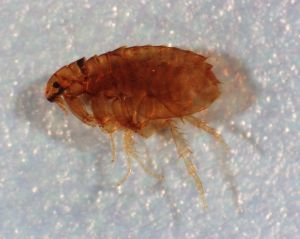What Fall Flea Freeze Out? Busting a Myth That Leaves Pets at Risk
As we head deeper into fall and the temperature starts to chill a bit, it’s easy to worry less about our pets suffering through flea infestations. After all, fleas and other blood-thirsty parasites don’t thrive in the freezing cold, right? That’s true for the most part, but it only paints part of the picture. Many great pet owners who love and provide dedicated care for their dogs and cats simply don’t realize the risk of fleas doesn’t fade with the summer heat. In fact, a quick Google search for winter flea protection prompts far too many results pointing to the common misconception that fleas won’t attack pets during the fall and winter. It’s time to review the facts, so we can help put that myth out to pasture.
The Fall Flea Surge
As a trusted veterinarian in Springfield, MO, where it gets awfully hot in the summer and bitterly cold in the dead of winter, I field all kinds of questions about why our patient families would need to treat their pets for fleas all year round. The answer is that the cooler temperatures and increased precipitation September tends to bring leads to the fall flea surge—as Dr. Michael Dryden, widely trusted Professor of Veterinary Parasitology at Kansas State University College of Veterinary Medicine, Manhattan, has deemed it.1 In fact, Dr. Dryden has found that wild animals carry 70 percent more fleas in the fall than in the summer! How did he discover that? He and his team actually sedated wild animals and then counted their fleas. One poor opossum played the unwilling host to over 1,000 fleas at the time of the research.1

It’s time to fight the fall flea surge.
The increased flea population during cooler months makes sense when one considers that thicker winter coats hide fleas when wildlife attempts to groom the pests away.2 Fleas find warm places to survive as long as possible, and there’s no host quite as a warm and cozy as a furry animal—including any dog or cat who enjoys free run of the house. When fleas attack pets and then make their way inside, they quickly make themselves at home. Fleas nest and lay 40 to 50 eggs every day, wherever they please. Carpets, clothing, and beds make it particularly easy for fleas to thrive throughout the winter.
Compounding the issue, fleas adapt to extreme cold with varying degrees of success during the different stages of life. For example, both adult fleas and flea eggs struggle when temperatures remain at 37°F or below, and they die if it remains that cold for more than 10 days. Flea pupae, on the other hand, are bundled up in a protective layer that can keep them alive in the frigid weather throughout the winter and beyond—for up to a full year.
The Winnable Fight Against Fleas
Unlike wildlife that can only rely on grooming to control fleas, your pets have an advocate to help protect them from fleas throughout the year. Whatever the season, a monthly flea preventive is critical to stopping flea infestations, and fall is the absolute worst time of year to cut back on flea control. If we erroneously let fleas off the hook during the cooler weather, those pesky parasites have a far better chance to invade our homes and happily overwinter with our pets.
The proven need for year-round flea control applies to pets of all ages. You already know the importance of scheduling preventive kitten shots and puppy vaccinations, but many people don’t realize even young animals can safely receive flea control medicines. At Deerfield Veterinary Hospital, we urge pet owners to begin a monthly preventive plan during the very first visit for their new kitten or puppy. That lets us protect the pet right from the start and gives our caring staff the opportunity to show new pet owners how to properly administer the medicine.
The year-round approach is equally important for elderly dog care and senior cat care. Although our older pals generally don’t go outside as often, that doesn’t mean they are at less risk of contracting fleas. As older pets slow down, they become easier targets for fleas and other parasites. Older cats typically aren’t as fastidious of groomers, so your elderly cat may not keep up that beautiful coat as well as when she was younger. Thankfully, we can prevent the discomfort and pain fleas cause for older pets. That’s even more crucial when considering any chronic underlying issues your beloved pet may be enduring.
Our Preferred Flea Control Methods
Thanks to the many powerful breakthroughs in parasite prevention in recent years, dealing with fleas and flea bite allergies is something our pets no longer need to do—at any age.
It is, of course, always important to consider the unique needs and living situation for individual pet patients before making a final choice of flea control medicines. So stop by Deerfield Veterinary Hospital or visit your local veterinarian to learn which option is best for your pet. While you’re there, ask about a few of the flea control methods I find to be particularly reliable and effective:
- Topical Flea Prevention for Dogs: Frontline and Revolution are great choices.
- Oral Flea Prevention for Dogs: Nexgard and Trifexis are known to work well.
- Topical Flea Prevention for Cats: Revolution is a reliable option.
- Oral Flea Prevention for Cats: Currently, there are no approved oral options for cats.
If you have any questions about flea prevention, we would love to meet your pet and recommend the option that’s right for his or her needs: Get in touch with a Deerfield Veterinary Hospital staff member.
References
- “No Foolin’ Fall Is Prime Flea Season.” Dale, Steve. Oct. 18, 2011. “Steve Dale’s Pet World” on the ChicagoNow website. Accessed Sept. 15, 2014 at chicagonow.com/steve-dales-pet-world/2011/10/no-foolin-fall-is-prime-flea-season/.
- “Why Fleas Surge in the Fall.” Dr. Bramlage, DVM. The Revival Animal Health website. Accessed Sept. 15, 2014 at revivalanimal.com/articles/Why-Fleas-Surge-in-Fall.html.


